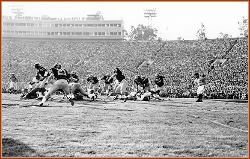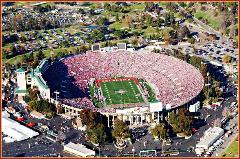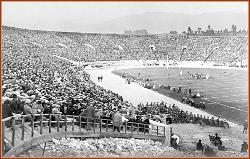



Stanford Stadium History
Located on the campus of Stanford University, it was built partly in competition with the
University of California, Berkeley to see who could build a football stadium first, Stanford
Stadium was built in four months and opened its gates on November 19, 1921. The first
game was against California, who defeated Stanford 42-7. Seating capacity was
originally 60,000, with a 66-row, U-Shaped structure second only to the Yale Bowl in size
at the time. In 1925, 10,200 seats were added to the stadium, nearly enclosing the
horseshoe while still keeping the overall height of the facility intact. Finally, in 1927, 14
additional rows of seating were added.
Renovations in the mid 1920s increased the Stadium to its maximum capacity of 85,500,
with 80 rows of seating. In 1960, a press box was added, while the first, and last athletics
track was installed in 1978.
In January of 1985, Super Bowl XIX was held in Stanford Stadium, bringing a renovated
press box, increased restroom facilities, and new locker rooms to the venue.
Other high profile events hosted at Stanford Stadium include Herbert Hoover's
acceptance speech for the 1928 Republican Presidential nomination, and international
soccer matches for the 1984 Summer Olympics, the 1994 FIFA World Cup, and the 1999
FIFA Women's World Cup. Each event resulted in additional changes to the stadium,
including a new press box and aluminum bench seating.
In 1935, Stanford Stadium set a record for single-game attendance, with 94,000
spectators filling the Stadium for a 13-0 victory over Cal.



Artist rendering in 1920 of the Stadium before it was built.
|
Stanford Stadium under construction in 1921.
|
Stanford Stadium before the renovation.
|
The Major Renovation of 2005
On June 7, 2005, Stanford University's Board of Trustees gave preliminary approval for a
major re-building of Stanford Stadium, the 85,500-seat facility that has been the home of
Stanford Football since 1921.
The trustees approved a concept plan presented by the Department of Athletics that will
modernize almost all facilities within the stadium, reduce the stadium’s capacity to 50,000
seats and bring spectators closer to the field. After approval by Santa Clara County,
construction began immediately following the last home football game against Notre
Dame on November 26. In December 2005, the Board of Trustees granted final approval
for the project, which allowed for construction to continue through completion.
The reduction in capacity was a strategic decision by Stanford's Athletics Program to
boost season ticket sales and create a more intimate playing atmosphere while
sacrificing the ability to host large world-class events, such as the FIFA World Cup or
NCAA Football Bowl Games in the future. This is partially the result of San Francisco's
failure to secure a bid for the 2012 Olympics, which would have featured a renovated
Stanford Stadium as the main Olympic Venue.
On June 22, 2006, a construction worker fell 23 feet to his death on site. Emergency
personnel responded within 5 minutes, but were unable to revive the worker.
The renovated stadium was originally to make its debut in Stanford's game against San
José State on September 9, 2006, but the game had to be relocated to San Jose due to
an unusually wet winter and resulting construction delays.







